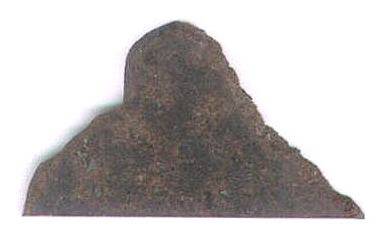AchondriteAn achondrite is a type of stony meteorite whose precursor was of chondritic origin and experienced metamorphic and igneous processes. They have a planetary or differentiated asteroidal origin where the chondritic parent body reached a sufficient size that through heating due to radioactive decay of 26Al (aluminum isotope) and gravitational Click on Term to Read More, ungroupedModifying term used to describe meteorites that are mineralogically and/or chemically unique and defy classification into the group or sub-group they most closely resemble. Some examples include Ungrouped Achondrite (achondrite-ung), Ungrouped Chondrite (chondrite-ung), Ungrouped Iron (iron-ung), and Ungrouped Carbonaceous (C-ung). Click on Term to Read More
(brachinite-like)

Found 1999
no coordinates recorded An oriented, fusion-crusted stone weighing 300 g was found near the site of the Zag meteoriteWork in progress. A solid natural object reaching a planet’s surface from interplanetary space. Solid portion of a meteoroid that survives its fall to Earth, or some other body. Meteorites are classified as stony meteorites, iron meteorites, and stony-iron meteorites. These groups are further divided according to their mineralogy and Click on Term to Read More fallMeteorite seen to fall. Such meteorites are usually collected soon after falling and are not affected by terrestrial weathering (Weathering = 0). Beginning in 2014 (date needs confirmation), the NomComm adopted the use of the terms "probable fall" and "confirmed fall" to provide better insight into the meteorite's history. If Click on Term to Read More in Morocco (see photo of main massLargest fragment of a meteorite, typically at the time of recovery. Meteorites are commonly cut, sliced or sometimes broken thus reducing the size of the main mass and the resulting largest specimen is called the "largest known mass". Click on Term to Read More with flow lines at the RSPD website). Zag (b) is an unbrecciated achondrite rich in forsteritic olivineGroup of silicate minerals, (Mg,Fe)2SiO4, with the compositional endpoints of forsterite (Mg2SiO4) and fayalite (Fe2SiO4). Olivine is commonly found in all chondrites within both the matrix and chondrules, achondrites including most primitive achondrites and some evolved achondrites, in pallasites as large yellow-green crystals (brown when terrestrialized), in the silicate portion Click on Term to Read More (68 vol%) that incorporates mm-sized orthopyroxeneOrthorhombic, low-Ca pyroxene common in chondrites. Its compositional range runs from all Mg-rich enstatite, MgSiO3 to Fe-rich ferrosilite, FeSiO3. These end-members form an almost complete solid solution where Mg2+ substitutes for Fe2+ up to about 90 mol. % and Ca substitutes no more than ~5 mol. % (higher Ca2+ contents occur Click on Term to Read More channels containing metalElement that readily forms cations and has metallic bonds; sometimes said to be similar to a cation in a cloud of electrons. The metals are one of the three groups of elements as distinguished by their ionization and bonding properties, along with the metalloids and nonmetals. A diagonal line drawn Click on Term to Read More or sulfide or weathered metal inclusions. These orthopyroxene and opaque assemblages exhibit several features that indicate the occurrence of a late reductionOxidation and reduction together are called redox (reduction and oxidation) and generally characterized by the transfer of electrons between chemical species, like molecules, atoms or ions, where one species undergoes oxidation, a loss of electrons, while another species undergoes reduction, a gain of electrons. This transfer of electrons between reactants Click on Term to Read More process, and the Fe–Mn–Mg relations are also consistent with reduction processes on the brachinite parent bodyThe body from which a meteorite or meteoroid was derived prior to its ejection. Some parent bodies were destroyed early in the formation of our Solar System, while others like the asteroid 4-Vesta and Mars are still observable today. Click on Term to Read More. Several methods for the reduction of primary olivine were reviewed by Goodrich et al., 2017), including its reaction with methane to form orthopyroxene + metal (Irving et al., 2013) and through its sulfurization by a S-rich fluid or gas to form orthopyroxene + sulfide (e.g., Singerling et al., 2013). Olivine and orthopyroxene exhibit variability in their distribution (Day et al., 2012). The oxygenElement that makes up 20.95 vol. % of the Earth's atmosphere at ground level, 89 wt. % of seawater and 46.6 wt. % (94 vol. %) of Earth's crust. It appears to be the third most abundant element in the universe (after H and He), but has an abundance only Click on Term to Read More isotopeOne of two or more atoms with the same atomic number (Z), but different mass (A). For example, hydrogen has three isotopes: 1H, 2H (deuterium), and 3H (tritium). Different isotopes of a given element have different numbers of neutrons in the nucleus. Click on Term to Read More ratios plot close to those for Divnoe, NWA 4042, and the brachinites, although Zag (b) has undergone a more thorough reduction process.
Zag (b) shares very close similarities with Divnoe and the brachinites in Fe ratios and oxygen isotopic systematics. Moreover, the
acapulcoitesPrimitive achondrite that belongs to a small group named after the Acapulco meteorite that was observed to fall in Mexico in 1976. Acapulcoites are made mostly of fine-grained olivine (Fo3-14), orthopyroxene(En86-97), Ca-rich pyroxene (En51Wo44), plagioclase (An12-31), Ni-Fe metal, and troilite. They are transitional between primordial chondritic matter and more differentiated Click on Term to Read More and lodranites fall on the same oxygen mixing line, and they have Fe–Mn–Mg features consistent with a close relationship to Zag (b), Divnoe, and the brachinites. All of these different meteorites likely formed in the same nebular region from common precursor material, with Zag (b) having an intermediate position between Divnoe and the ACA–LOD cluster. Because of its close relationship to Divnoe, and by extension, the brachinites, Zag (b) is sometimes conveniently included with the brachinites in classification studies. Further information about Zag (b) can be found in the abstract ‘Zag (b): A Ferroan Achondrite Intermediate Between Brachinites And Lodranites’ by Delaney
et al., 31st LPSC,
#1745 (2000).
On a newly compiled
O-isotope diagram for brachinites and other planetary achondrites, published by Rumble III
et al. (2008), Zag (b) has a Δ
17O value that plots within a select grouping of brachinites including NWA 3151, NWA 595, and the ungrouped brachinite-like achondrite NWA 4042, and these investigators believe that Zag (b) should probably be lumped with the brachinites. However, through studies of highly
siderophile elementLiterally, "iron-loving" element that tends to be concentrated in Fe-Ni metal rather than in silicate; these are Fe, Co, Ni, Mo, Re, Au, and PGE. These elements are relatively common in undifferentiated meteorites, and, in differentiated asteroids and planets, are found in the metal-rich cores and, consequently, extremely rare on (HSE) abundances, and upon examining the metal-sulfide segregation processes, it was determined by Day
et al. (2012) that Zag (b) and similar brachinite-like achondrites were not likely genetically related (
i.e. from the same parent body) to brachinites, but rather, originated on similar volatile-rich,
oxidizedOxidation and reduction together are called redox (reduction and oxidation) and generally characterized by the transfer of electrons between chemical species, like molecules, atoms or ions, where one species undergoes oxidation, a loss of electrons, while another species undergoes reduction, a gain of electrons. This transfer of electrons between reactants Click on Term to Read More, chondritic precursor asteroids while experiencing similar petrologic processes during their formation history. Goodrich
et al. (2017) determined that brachinites and brachinite-like achondrites have a distinct
redoxOxidation and reduction together are called redox (reduction and oxidation) and generally characterized by the transfer of electrons between chemical species, like molecules, atoms or ions, where one species undergoes oxidation, a loss of electrons, while another species undergoes reduction, a gain of electrons. This transfer of electrons between reactants Click on Term to Read More trend and a higher Fe/Mg ratio compared to all other primitive achondrites, consistent with formation in a similar
nebulaAn immense interstellar, diffuse cloud of gas and dust from which a central star and surrounding planets and planetesimals condense and accrete. The properties of nebulae vary enormously and depend on their composition as well as the environment in which they are situated. Emission nebula are powered by young, massive Click on Term to Read More reservoir; therefore, they suggest that brachinites and brachinite-like achondrites be called the brachinite clan.
The measured HSE abundances are consistent with a partially melted parent body in which heating from short-lived radionuclides came to a halt before a
coreIn the context of planetary formation, the core is the central region of a large differentiated asteroid, planet or moon and made up of denser materials than the surrounding mantle and crust. For example, the cores of the Earth, the terrestrial planets and differentiated asteroids are rich in metallic iron-nickel. Click on Term to Read More was fully formed. Studies of the
fractionationConcentration or separation of one mineral, element, or isotope from an initially homogeneous system. Fractionation can occur as a mass-dependent or mass-independent process. Click on Term to Read More trends for Zag (b) led Day and Warren (2015) to conclude that this meteorite might not have been a residue after
partial meltingAn igneous process whereby rocks melt and the resulting magma is comprised of the remaining partially melted rock (sometimes called restite) and a liquid whose composition differs from the original rock. Partial melting occurs because nearly all rocks are made up of different minerals, each of which has a different melting Click on Term to Read More, but instead represents a
cumulateIgneous rock composed of crystals that have grown and accumulated (often by gravitational settling) in a cooling magma chamber. Click on Term to Read More that incorporated a residual metallic melt with a high Pt/Os ratio; the ungrouped cumulate achondrite NWA 6704 and the brachinite-like cumulate achondrite MIL 090206 (and pairings) exhibit similar elevated Pt/Os ratios.
The specimen of Zag (b) shown above is a 2.2 g partial slice. A microscopic examination reveals the yellow-green olivine enclaves scattered throughout this meteorite.







